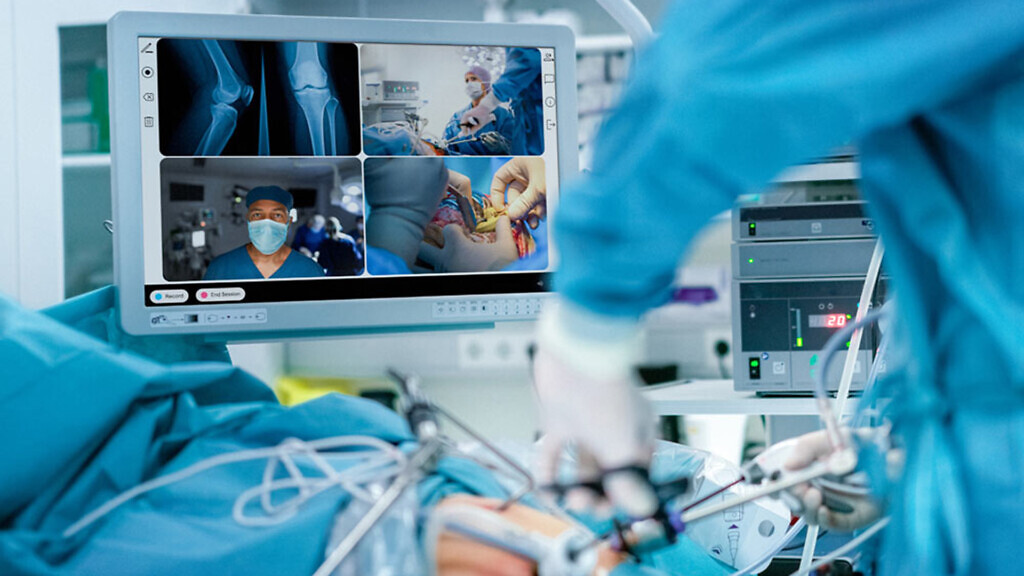The surgeon and Proximie chief executive explains why she thinks smart operating rooms are the way forward for hospitals to be optimally efficient.
As a practising surgeon and the founder and chief excutive of Proximie, a fast-scaling healthtech firm, Dr. Nadine Hachach-Haram feels that the key to optimising efficiencies in the operating room is through virtual collaboration and smart data sharing.
Talking to Healthcare Today at HLTH Europe in Amsterdam, she explains why digitising operating rooms and driving AI-powered insights from surgical data helps to improve patient outcomes, improve productivity and reduce workforce burnout…
What problem were you trying to solve when you set up Proximie?
I’m a practising surgeon, so I’ve seen the fundamental challenges of healthcare and surgery first-hand.
With surgery, there is a huge supply-and-demand gap. We have loads of patients on waiting lists. We have finite operating rooms (ORs) and we’re not going to build 100 more operating rooms or create hundreds of more surgeons overnight. How are we going to connect expertise, share best practices and accelerate the delivery of care in a safe and proactive way?
Operating rooms are hugely expensive assets for a hospital and, when you think about the equipment, the staff, the real estate and so on, it’s all quite analogue. Patients are wheeled in, surgery is done, and patients are wheeled out, someone writes up the case notes, and it’s onto the next…
Proximie’s solution was intelligent, connected operating rooms. They are, I feel, a real solution for optimum efficiency because they can help us scale expertise by allowing us to train twice as many doctors and nurses in half the time and also virtually connect to any expert who can guide you and give you expertise during a case.
Additionally, smart operating rooms allow you to collect and synthesise data sets, collating the data sitting on medical record systems and devices into actionable insights that optimise operational workflow.
Early results showed we could increase productivity by up to 24%.

How has this been received by people working in these operating rooms?
There’s a huge appetite for solutions that take off that burden, especially since healthcare workers spend about 30% of their time on documentation. The key insight was that it can’t be one operating room here, one operating room there, you have to go enterprise-wide to create truly smart, connected, data-driven ORs.
This means building tools to automate your operation notes, your coding and so on… The more you can remove the human from repetitive task loops, the more staff can practice at the top of their license. With a presence in 800 hospitals across 50 countries, the Proximie model is proving effective.
The NHS in particular is such a patchwork of so many different elements. How do we tackle the issue of that connectivity?
We’re in about 30% of NHS hospitals already, but there are still challenges with the NHS. You still have to go from hospital to hospital, going through approval processes at each stage. I hope that more central power will streamline this issue soon.
In the meantime, although some are frustrated with the pace of the NHS to adapt to change, we believe we can add a lot of value and so we’re working with hospitals up and down the country really to help them bring that value.
How do you see AI changing surgical training and collaboration in the next five years?
Not every AI model needs to become a company, which is why we built a platform where researchers can deploy models without starting businesses. Imagine a small team creates a blood loss detection algorithm, for example, they shouldn’t need to build a sales team to get it into ORs.
This collaborative approach means the models themselves become commoditised. It’s about deployment in clinical contexts. We’re already running other people’s models in our system to accelerate real-world impact.
“Walking in with a hammer isn’t the answer, but neither is accepting the status quo.”
How do regulatory challenges within the UK compare to, say, the US and Europe?
Every country has its preferred approaches, so going global requires difficult choices early on. We own the whole stack, we have no third-party dependencies that might work in one market but not another. This meant building flexibility to work with AWS, Azure, or other regional cloud providers from day one. But, once you’ve done the hard work of compliance, scaling becomes about proving value. That’s why we invested early in getting the architecture right, it’s now paying dividends across 50 countries.
As a leader in clinical and tech innovation, what lessons have you specifically learned at the intersection of medicine and entrepreneurship?
I feel privileged to sit at this intersection because having walked the walk as both clinician and entrepreneur changes your perspective. Too often, people opine about innovation without having to execute.
My role is to help technologies with good product-market fit demonstrate return on investment quickly by connecting entrepreneurs, providers and investors. The urgency comes from knowing the status quo in healthcare doesn’t work anymore.
As it pertains to healthcare, do you feel that disruption is the way forward, considering how reluctant some healthcare providers can be to evolve?
Walking in with a hammer isn’t the answer, but neither is accepting the status quo. The sweet spot is when hospitals help co-develop solutions and solve problems through collaboration.
Evidence of change is everywhere. Hospitals now hire chief AI officers and innovation teams. While five years ago, digital ORs seemed impossible, today they’re becoming the gold standard.



